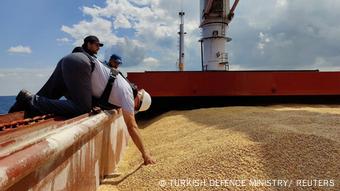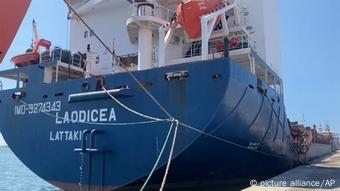
Bread in Lebanon is scarce and very expensive. In recent weeks, people have queued for hours in front of bakeries. Despite state subsidies, a six-pack of pita bread is now officially priced at 13,000 Lebanese pounds, which equates to around 8.5 euros. On the black market, the price is twice as high and continues to rise.
Waiting for wheat, not corn
So it was a glimmer of hope that the first cargo ship to leave Ukraine under the four-way grain deal was heading to Lebanon. But just before reaching the port of destination – Tripoli – the ship Razoni with 26,000 tons of corn on board changed course. According to the official version, the buyer refused to receive the shipment, which was five months late. Also, Lebanon mainly needs wheat, not corn, Hani Bushali, president of the food import consortium, told dpa. So the Razoni had to continue sailing the Mediterranean for a few more days, until a new corn buyer was found in Turkey.
The bread line is a typical image of Lebanon
In many countries, wheat is the number one food. However, the next ships were also loaded with corn or sunflower meal from Ukraine.
Who makes charge decisions?
Why is this happening? The Joint Coordination Center (JCC) established by Russia, Ukraine, Turkey and the UN for the safe transport of grain from Ukrainian ports did not respond to DW’s request. The JCC website states: “Shipping companies make decisions about the movement of their ships based on their business and interests.”
In addition, only a few shipments of grain are purchased by the UN World Food Program and delivered directly to hungry people around the world. As for the other twelve freighters that have already left Ukraine, the JCC has no right to decide which grain goes where. Previous ports of destination were, for example, Turkey, the United Kingdom, Ireland or South Korea.
“These are commercial agreements”, defends the UN spokesman, Stephane Dujarric, the procedure: the ships “were contracted as part of commercial agreements”, it is “quite normal that they go where they should by contract”.
Slow grain export
Twelve cargo ships – and about 22 million tons of wheat still stored in Ukraine. Grain exports are slow, and for several reasons.
First, Ukrainian ports can currently operate with only a small part of their pre-war capabilities.

Checking grain loaded in Istanbul
Second, when ships enter the Black Sea, they are checked in Istanbul to see if they are carrying smuggled weapons. On the way back, a check is made to see if there is any stolen grain on board. These checks cost time and money.
Third, there is no certainty that it will be possible to charter a sufficient number of ships. Many insurers do not want to insure transport from the conflict zone. As a result, only part of the grain currently stored in Ukraine can be exported.
Is Russia Transporting Stolen Grain by Ships?
In addition, there is a dispute over grain allegedly stolen by Russia. The Syrian-flagged freighter Laodicea was detained in Tripoli a few days ago. According to the Ukrainian embassy in Beirut, the ship was carrying 10,000 tons of stolen Ukrainian grain.
According to official documents, Laodicea arrived from the port of Kavkaz, located on the shores of the Kerch Strait, the second largest Russian port in the Black Sea-Azov basin in terms of cargo handling. As this port is not in a war zone, ships leaving there are not under the control of the JCC. However, according to the Reuters news agency, only ships with a maximum draft of five meters can dock at the port of Kavkaz. The Ukrainian embassy also handed over satellite images to authorities in Beirut, which prove that the cargo ship first approached the Crimea port of Feodosiya empty and then left with heavy cargo.
Ukrainian diplomats suspect that grain from Russian-occupied territories in southern Ukraine has been taken out of the country, a view shared by well-known Turkish security expert Yeruk Isik of the Istanbul Institute of the Middle East.
With transponder off
According to an investigation by the British edition of the Financial Times (FT), the Laodicean story is far from unique. As early as May, based on satellite imagery, the FT identified at least eight ships laden with grain not in Russia but in Crimea’s sanctioned port of Sevastopol. According to official shipping documents, since the beginning of the war, significantly more ships have left the port of Kavkaz than before, and their actual route cannot always be traced.

The ship Laodicea was detained in Lebanon on suspicion of transporting stolen Ukrainian grain
Under the rules, international cargo ships are required to constantly provide their position data via a transponder. However, in the case of Russian cargo ships in the Black Sea, these transponders are often turned off. According to the FT, it is possible that these ships loaded only a small amount of legal Russian grain at the port of Kavkaz and then mixed it with stolen Ukrainian grain at one of the Crimean ports. In this case, experts say, it is extremely difficult to track whether the shipments contain grain stolen from Ukraine.
In the Middle East, they close their eyes to the origin of grains
Often these Russian grain ships are shipped to Middle Eastern ports. Among the buyers are Iran, Egypt or Libya. The grain is so urgently needed that authorities generally do not question its origin. However, the main customer was and remains Damascus. According to reports, at least 90,000 tons of grain have arrived in Syria since the start of the war. Syrian ruler Bashar al-Assad is a close ally of Putin.
The ship Laodicea, which was detained in Lebanon, was also on its way to Syria. Lebanese authorities allowed him to continue his journey without revealing any wrongdoing. Marinetraffic.com recorded the vessel’s last position on August 4, near the Syrian port of Tartus.
Source: DW
Anna White is a journalist at 247 News Reel, where she writes on world news and current events. She is known for her insightful analysis and compelling storytelling. Anna’s articles have been widely read and shared, earning her a reputation as a talented and respected journalist. She delivers in-depth and accurate understanding of the world’s most pressing issues.